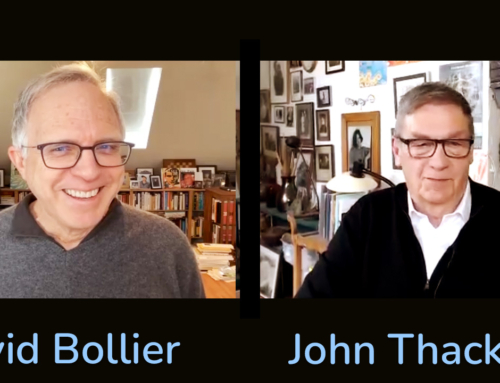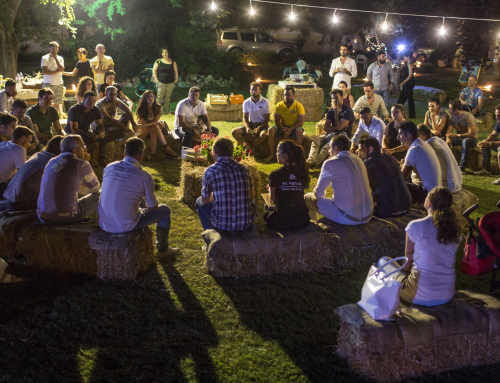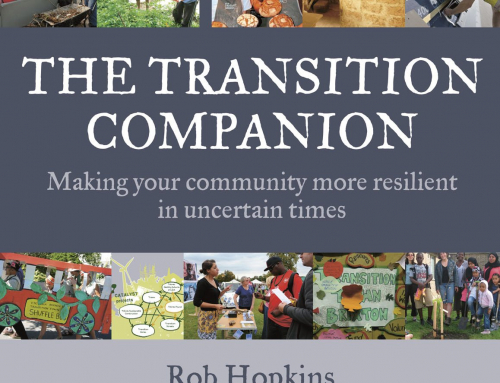A lecture given to the Design Recast conference organised (by Jouke Kleerebezem) at the Jan Van Eyck Academy in Maastricht.
Trying to get a grip on design is rather like trying to grab hold of a shoal of herring. Orca whales do this by blowing upside-down funnels of air bubbles from underneath the shoal – somewhat like a martini glass – and then gulp the whole lot down in one go as the shoal swirls helplessly round. After the last couple of days, I can’t decide whether I feel like a herring, or the whale…
Architecture and design have to change faster if they are to be effective, or even meaningful, in today’s context. We have filled the world with complex systems and technologies – on top of the natural ones that were already here, and social-cultural systems that have evolved over thousands of years. We live in world of human, natural, and industrial systems whose complex interactions are hard to comprehend. These systems are, by their nature, invisible – so we lack the clear mental models that we might otherwise use to make sense of the bigger picture. The design of Large Technical Systems, pervasive software, and the inaptly named ‘ambient intelligence’, is an almost unimaginably complex process. To be effective in such a context, design needs to be renewed, and transformed. But in what ways? And how?
In recent years we were told that these systems were ‘out of control’ – too complex to understand, let alone to shape, or re-direct. But ‘out of control’ is an ideology, not a fact. In architecture, in particular, this ideology fostered a kind of cultural autism, an absorption in self-centered subjective activity, accompanied by a marked withdrawal from reality.
But there is something we can do. It’s called design: the “first signal of human intention”.
If you look at the mainstream of architecture, the prospects for change look bleak. Many design professionals have retreated into denial and narcissism. Their projects deal mainly with appearances, and are fashioned to enhance the celebrity of their creators. More insidious are those designers who have adopted the language of complexity and networks – only to become craven servants of what Manuel Castells calls “The Automaton” or Alasdair Grey, in Lanark, “The Machine”.
Exulting in forces ‘too big for us to control’, this second group has taken it upon themselves to amplify, to accelerate, the powerful forces unleashed by neo-liberal values (or the lack of them) and new technology. These designers don’t just go with the flow, they speed it up. The result is the glorification of fast cities, of extra large cities, and of 24-hour cities – a big interest in fast trains, and in high-end shopping – but little attention to social quality, learning, innovation, or sustainability.
Things are not much better in communication design. We do not know how to design communication. We know how to design messages, yes: the world is awash in print and ads and packaging and e-trash and spam. But these are all one-way messages, the output of a point-to-mass mentality that lies behind the brand intrusion and semiotic pollution that despoil our perceptual landscape. I’ll return to this issue later; right now I want to focus on two missing communication flows that need to be designed: social communication, and ecological communication.
That sad picture, for me, is the empty half of the bottle. But the bottle of design innovation is half-full – and rising. Profound change in design is already underway. Being bottom-up, and outside in, these changes are barely visible on the official radars of architecture – its media, schools, and professional bodies. But these changes are real.
I will focus on two axes in this transformation of the design process. The first axis concerns the understanding and perception of processes that shape today’s shifting urban conditions. The second axis is about modes of intervention – exploring new kinds of design moves in which we are blind to the precise outcome of particular actions – but militant promoters of the core values I mentioned above: social quality, learning, innovation, and sustainability.
Design for legibility
The emerging model of architectural and urban design incorporates what we know about the behaviour of biological organisms, the geometry and information processing systems of the brain, and the morphology of information networks. In order to do things differently, we first need to see things differently. We need to re-connect with the systems and processes on which we depend. We need to understand them, in order to look after them.
Many affective representations of complex phenomena have been developed in recent times. Physicists have illustrated quarks. Biologists have mapped the genome. Doctors have described immune systems in the body, and among communities. Network designers have mapped communication flows between continents, and in buildings. Managers have charted the locations of expertise in their organizations. So far, these representations have been used, by specialists, as objects of research – not as the basis for real-time design. That is now changing. Real-time representations are becoming viable design tools.
Representations of energy flows, for example, are now achievable. And a priority. All our design processes should aspire to reduce the ecological footprint of a city. Man and nature share the same resources for building and living. An ecological approach will drastically reduce construction energy and materials costs, and allow most buildings in use to export energy rather than consume it. Natural ecosystems have complex biological structures: they recycle their materials, permit change and adaptation, and make efficient use of ambient energy. Real-time representations of energy performance can help us move closer to that model in the artificial world.
I emphasize that I am not talking about simulations, here, but about real-time representations.
We should also visualize connectivity. Many of us here, I am sure, enjoy charts that map the number of people connected to the Internet, or the flows of bits from one continent to another. They make really sexy infographics. But I am not just talking about information as spectacle, or as porn. An active intervention in the architecture of connectivity means mapping communication flows in order to optimise them. We need to understand overlapping webs of suppliers, customers, competitors, adults, and children – to identify communication blockages and then to fix the ‘plumbing’ where flows don’t work.
We also need to investigate change processes at a ground level. In a recent issue of Hunch, edited by my friend Jennifer Sigler at the Berlage Institute in Rotterdam, I lauded a project called Wild City which mapped the interactions between non-regulated processes (street traders) and existing city fabrics (the green market, or a department store). I’m not convinced that the researchers’ initial research hypothesis was proved: they set out “to point out the undiscovered potentials of specific locations” – but, for me, that was not the main point. The Wild City project delivered new notational tools for perceiving ‘actors’ and ‘forces’ that previously did not figure – to use a fusty architectural term – in urban design notation.
A further design challenge would render more of these process representations visceral. Maurice Merleau Ponty, an early critic of blueprint thinking in architecture and design, said that we need to move beyond “high altitude thinking… towards a closer engagement with the world made flesh”. And Luis Fernandez-Galiano, in his remarkable book Fire and memory, argues that we need to shift our perceptions “from the eye to the skin” – to develop not just an understanding but also a feeling of how complex urban flows and processes work.
Architects are not famous for being in touch with their feelings, so I do not anticipate fast progress on this particular front.
Sense-and-respond design
Evolution operates without prior knowledge of what is to come – that is, without design. But culture does not. The purpose of systems literacy in design is not to watch from outside. It is to enable action. We need to develop a shared vision of what we need to do, together, and how. We need to re-discover intentionality and learn, once we can read them, how to shape emergent urban and industrial processes.
A first step is learning how to think backwards from a desired outcome. To identify the things that need fixing, and to foster creativity in the search for new questions, we need to become expert at a process called ‘back-casting’ .We learned a lot about this technique during the 1990s at the Vormgevingsinstituut in Amsterdam. The trick is to develop scenarios of everyday life in the not-too-distant future: for example, a city in which 90 per cent of food is eaten within 50km of where it is produced; or a community in which fifty per cent of the teaching in a local school is done by people living in the area; or a health system based on peer-to-peer knowledge-sharing among hospitals, doctors, and citizens, enabled by the web. [The best book I know on such scenarios, by the way, is David Siegel’s Futurize your enterprise. Our own book Presence: new media and older people is also pretty good].
We put these scenarios into workshops with professionals from mixed backgrounds, and asked them to work the consequences through backwards from then, to now. On that ‘backwards’ road, we developed the capacity to spot opportunities at the juncture between physical and virtual networks, and to imagine relationships and connections where none existed before (in much the same way that processes were visualised in Wild City).
Back casting and scenarios are neither fantasies, nor a new variety of theoretical onanism. Design scenarios are about the real world. We need to use as design tools, as the basis for real-world interventions to ‘steer’ complex urban transformations. Scenarios can help us connect an understanding of urban genetics with real-time actions to nudge ‘self’ organising systems in a desired direction.
[I should mention that design scenarios are quite different from autonomous or so-called intelligent design tools, such as genetic algorithms and cellular automata. The Artificial Intelligence (AI) community has shown that it is feasible to design self-generating code that can plot the lines of complex shapes, such as a boat hull. It was once thought that ‘intelligent’, generative design tools might help architects design the processes or codes, the ‘rules of the game’ or ‘shape grammars’, by which forms are generated, rather than the end product itself in detail. Researchers continue to look for ways to harness the formidable power of computers to do prototyping, modelling, testing and evaluation, thus compressing the time and space needed for products to evolve. For researchers like John Fraser this means designing the overall system: “you design the rules, rather than the actual individual stylistic detail of the product”.
But neither shape-generating algorithms, nor self-replicating software viruses, are appropriate for the continuous intervention in continuously evolving urban systems – for three reasons. First, because urban processes are not shapes. Second, because self-replicating software does not allow for sense-and-respond feedback. Third, because intelligent design tools are just that: tools. They can and do exist independently of the physical and social context without which a sense-and-respond design process is impossible.
In biology, they describe as choronomic, the influence on a process of geographic or regional environment. Choronomy adds value; a lack of context destroys it.
The irony is that while city and building designers have been flirting with semi-autonomous, evolutionary design processes, the most advanced software designers, who call themselves ‘extreme programmers’, are headed in the opposite direction – back towards human-steered design. Extreme programmers prefer to do it, than watch it. They have come to value individuals, and interactions among them, over abstract processes and tools. They find it more important to engage directly with working software, than to labour at the design of self-organizing systems. These principles are the basis of a new movement in software called The Agile Alliance.
As designers, we all need to be Agile. Our best intentions – for social quality, for sustainability, for learning, for play – will remain just that – intentions – until we complete the transition from designing on the world to designing in the world.
Natural, human and industrial systems are all around us – they are not below, outside, or above us. In design, if we are to take this new subject-object relationship seriously, we need to shift from a concern with objects and appearances, towards a focus on enhanced perceptions of complex processes – and their continuous optimisation.
We need to think of ‘world’ as a verb, not as a noun. We need to think of rowing the boat, not just of drawing it.
The transformation from designing for people, to designing with people, will not be easy. Anyone using a system – responding to it, interacting with it, feeding back into it – changes it. Complex technical systems – be they physical, or virtual, or both – are shaped, continuously, by all the people who use them. Think of Netscape, or Napster. In the world as a verb, it won’t work to treat people as users, or consumers or viewers. We need to think of people – of ourselves – as actors.
As designers, our role is evolving from shaping, to steering; from being the ‘authors’ of a finished work, into facilitators who help people act more intelligently, in a more design-minded way, in the systems they live in.
Our business models in design also have to change. The idea of a self-contained design project – of ‘signing off’, when a design is finished – makes no sense in a world whose systems don’t stop changing. Design’s project-based business model is like a water company that delivers a bucket of water to your door and pronounces its mission accomplished. We need to evolve new business models for design – models that enable design to operate as a continuous service, not as manufacturing process.
One scenario, which we are discussing next week at a workshop on new business models in Ivrea, is a design economy based on service contracts, such as those used by big management consultancy firms.
Someone told me that every lecture should end with an answer to the question: what do I do with this information on Monday morning, when I go back to work? It’s a reasonable question, but I can’t answer it directly. Italo Calvino, however, tells a wonderful story – so I’ll tell you his.” Among Chuang-tzu’s many skills, he was an expert draftsman. The king asked him to draw a crab. Chuang-tzu replied that he needed five years, a country house, and twelve servants. Five years later, the drawing was not begun.” I need another five years,” said Chuang-tzu.The king granted them. At the end of these ten years, Chuang-tzu took up his brush and, in an instant, with a single stroke, he drew a crab, the most perfect ever seen”.
For Calvino, literature was a search for knowledge.” My work as a writer”, he said, has, from the beginning, aimed at tracing the lightning flashes of mental circuits that capture and link points distant from each other in space and time”. Might we not think of design in a similar way?
Maastricht April 2002



